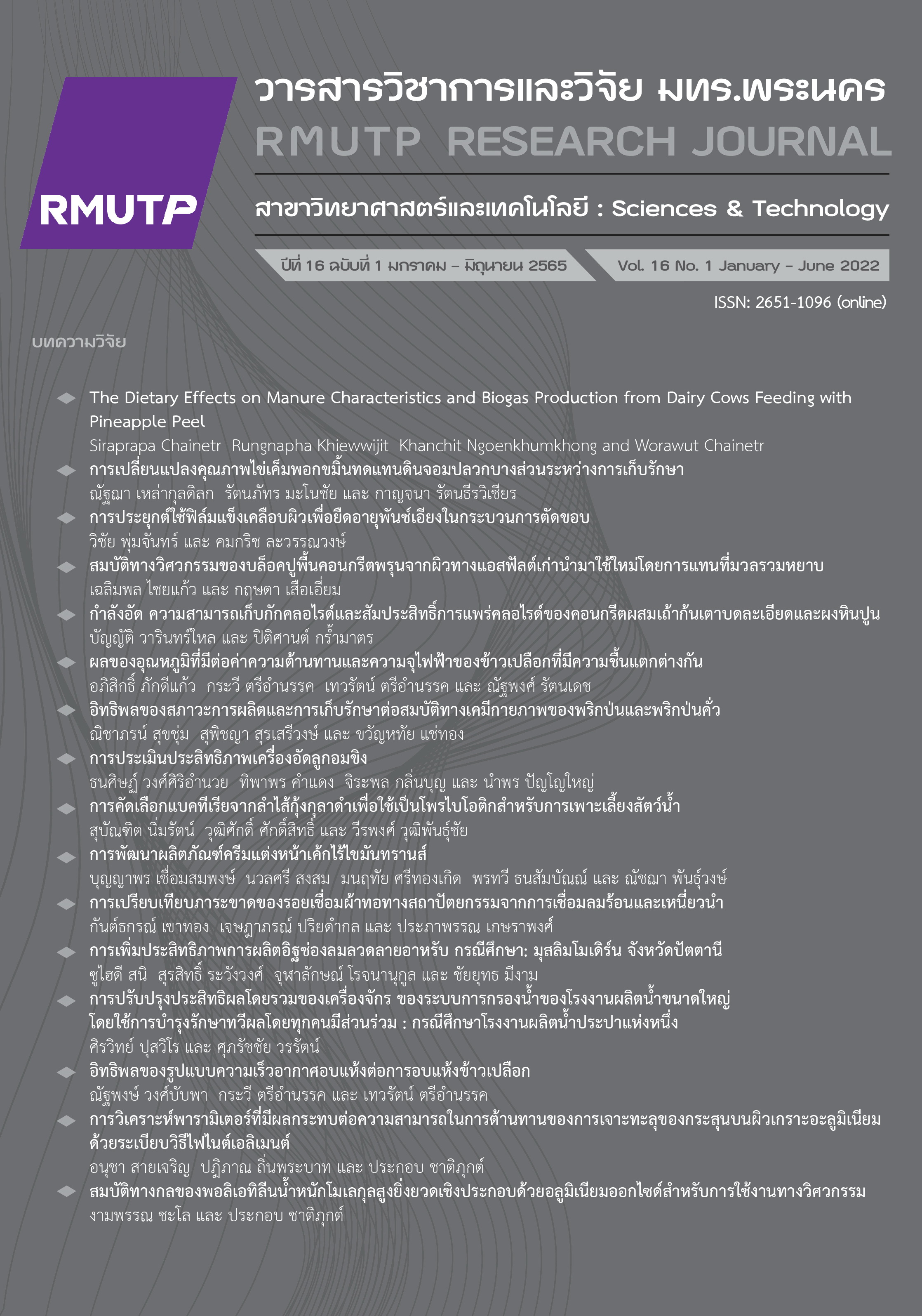The Comparison of Failing Load of Architectural Fabrics of Weld Seams Between the Hot Air Welding and High Frequency Welding
Main Article Content
Abstract
Architectural fabrics were continuously developed on their unique performance. Architects and Engineers designed them for the application of important buildings around the world despite the symptom that Architectural fabric sizes from manufactures are smaller than the application sizes. Recently, although the well-known method used to weld Architectural fabrics to enlarge their size is the high frequency welding, there were some application issues. To mitigate those issues, the researcher created the hot air welding to replace the high frequency welding in consideration on the failing loads of welded seams which are variable factors of the failing loads to indicate the weld strength and it is crucial for the Architectural fabric application. This research presents the comparison of failing load of weld seams between the hot air welding and high frequency welding by the test of Taguchi's Orthogonal arrays L25 method. The test results demonstrated that Architectural fabrics welded by the hot air welding has the highest failing loads of wrap, equal to 95.38 kN/m and the highest failing loads of weft at 86.17 kN/m. Conversely, Architectural fabrics welded by the high frequency welding has the highest failing loads of wrap, equal to 101.37 kN/m and the highest failing loads of weft at 97.78 kN/m. Based on a forementioned results, there is no significant difference from both welding methods and thus concluded that the hot air welding could be used to replace the high frequency welding method.
Article Details

This work is licensed under a Creative Commons Attribution-NonCommercial-NoDerivatives 4.0 International License.
ลิขสิทธ์ ของมหาวิทยาลัยเทคโนโลยีราชมงคลพระนครReferences
Luo Yixi, Hu Hong and R. Fangueiro, “Tensile and tearing properties of PVC coated biaxial warp knitted fabrics under biaxial loads,” Indian Journal of Fibre & Textile Research, vol. 33, no. 2, pp. 146-150, Jun. 2008.
Andrzej Ambroziak and Pawel Klosowski, “Mechanical properties for preliminary design of structures made from PVC coated fabric,” Construction and Building Materials, vol. 50, no. 1, pp. 74-81, Jan. 2014.
A. Ambroziak, “Mechanical properties of Precontraint 1202S coated fabric under biaxialtensile test with different load ratios,” Construction and Building Materials, vol. 80, no. 2, pp. 210-224, Apr. 2015.
K. Khaothong, W. Chaiworapuek, and J. Priyadumkol, “Pressure loss diagram of air flow in polyester fabric duct acrylic PVC coated,” The Journal of KMUTNB, vol. 29, no. 3, pp. 445–453, Jul.–Sep. 2019.
T. Shi, W. Chen, C. Gao, J. Hu, B. Zhao, D and Zhang, Z. Qiu, “Shear behavior of architectural coated fabrics under biaxial bias extension,” Construction and Building Materials, vol. 187, no. 6, pp. 964-973, Oct. 2018.
S.S. Volkow, “Ultrasound welding of synthetic fabric for technical purposes,” Welding International, vol. 23, no. 10, pp. 789-795, Sep. 2009.
Kunthakorn Khaothong, Kanit Manatura and Tinnasit Krisinburasak, “Influence of Hot Air Welding Parameters for Architecture Canvas,” in Proceeding of 31th Conference on Mechanical Engineering Network of Thailand (MENET), Thailand, 2018, pp. 926–934.
Hui Shi, Jianping Wang, Xiaona Chen, Shunhua Luo and Lingxi Zhang, “Research on the seam performance of waterproof clothing based on continuous ultrasonic welding technology,” International Journal of Clothing Science and Technology, vol. 28, no. 2, pp. 171-190, Mar. 2016.
P.Q. Jiang, Y.F. Lai and Chen. X. Sh, “Seam mechanical properties of polyester /cotton blended woven fabric welded by ultrasonic sewing machine,” Journal of Donghua University (Natural Science), vol. 39, no. 5, pp. 283-285, Mar. 2013.
Jiang. P.Q, Lai, Y.F. and Chen. X.Sh, “Seam mechanical properties of polyester fabric welded by ultrasonic sewing machine”, Journal of Textile Research, vol. 34, no. 3, pp. 127-130, Oct. 2013.
Kunthakorn Khaothong, “Analysis of Failing load and optimization of hot air welding parameters on PVC-Acrylic coated polyester fabric by taguchi and ANOVA Technique,” Engineering Journal, vol. 23, no. 6, pp. 331-334, Nov. 2019.
Kunthakorn Khaothong, “Experimental setup for measuring thermal conductivity of architecture fabrics,” Engineering Journal of Research and Development Journal, vol. 31, no. 1, pp. 145-154, Jan. 2020.
Tensile - architecture. (2020, Oct 1). [Online]. Available: http://www.sioen technicaltextiles.com
L. Kun, A.C. Murariu, “Research on the Influence of Artificial Ageing on the Tensile Properties of Plastic Coated Composites with Fabric Inserts,” in Proceeding of 7th International Conference on Innovative Technologies for Joining Advanced Materials (TIMA), Romania, 2014, pp. 224-229.
Ranjit K. Roy, Design of Experiments Using The Taguchi Approach: 16 Steps to Product and Process Improvement. 1 st ed. New York: Wiley-Interscience, 2001.
Douglas C. Montgomery, Design and Analysis of Experiments, 9th ed. New York: John Wiley and Sons, 2017.
L. Kun, A.C. Murariu, A.V. Bîrdeanu and K.N. Kun, “Development of an experimental program for optimizing of process parameters used in high frequency welding of PVC coated PE fabrics,” Welding & Material Testing Science, vol. 3, no. 3, pp. 3-8, Jan. 2014.


